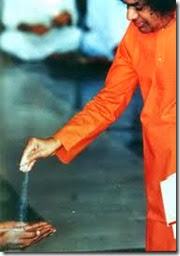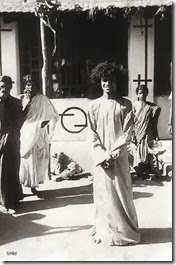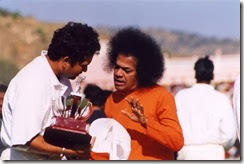Baba has often spoken of the significance of this Vibhuti. Since it is materialized out of nothing and since the Ash is specifically associated with Siva, it is reverentially known by devotees as Kailasa Vibhuti, the sacred Ash of Siva who resides on Mount Kailasa. It is named Vibhuti since it endows one with prosperity; Bhasma - "ashes" because it burns away all sins; Bhasitam - "brightened" because it increases one's spiritual splendor; Ksharam - "destruction" since it removes danger; and Raksha - "protector" for it is an armor against the machinations of evil spirits. This is how the Vibhuti is praised in the Brihad Jabala Upanishad, one of the ancient spiritual texts. Baba says Vibhuti is also a constant reminder of the evanescence of the body which, ultimately, is reduced in cremation to a potful of ash!
Vibhuti is the most precious object in a spiritual sense. Shiva burnt the God of Desire for he agitates the mind and increases the confusion already existing there. Shiva burnt him into a heap of ashes. When the God of desire was destroyed, Prema (Love) reigned supreme. When there is no desire to control the mind, love can be true for all.
agitates the mind and increases the confusion already existing there. Shiva burnt him into a heap of ashes. When the God of desire was destroyed, Prema (Love) reigned supreme. When there is no desire to control the mind, love can be true for all.
The application of this Holy Ash is a reminder for us to achieve our victory over desire. Ash is the ultimate condition of things; it cannot undergo any further change. Ash cannot fade as flowers do in a day or two, it does not dry and disappear or get soiled and unpotable as water does. It does not lose colour as leaves do in a few hours and it does not rot as fruits do in a few days.
Ash is ash forever and ever. This state of ash reminders us of our true nature, which is the atma, our soul. Our soul never undergoes any change. So burn your vices, your bad habits, and worship the Lord rendering yourself pure in thought, word and deed. Reach the state of nothingness and attain liberation by absorbing the essence of the vibhuti that we apply on our foreheads.
When we recite this vibhut mantra, we say “I take refuge in the supremely sacred vibhuti of the Lord, the wonderful vibhuti which bestows liberation, the sacred state which I desire to attain.”
Vibhuti is the most precious object in a spiritual sense. Shiva burnt the God of Desire for he agitates the mind and increases the confusion already existing there. Shiva burnt him into a heap of ashes. When the God of desire was destroyed, Prema (Love) reigned supreme. When there is no desire to control the mind, love can be true for all.
The application of this Holy Ash is a reminder for us to achieve our victory over desire. Ash is the ultimate condition of things; it cannot undergo any further change. Ash cannot fade as flowers do in a day or two, it does not dry and disappear or get soiled and unpotable as water does. It does not lose colour as leaves do in a few hours and it does not rot as fruits do in a few days.
Ash is ash forever and ever. This state of ash reminders us of our true nature, which is the atma, our soul. Our soul never undergoes any change. So burn your vices, your bad habits, and worship the Lord rendering yourself pure in thought, word and deed. Reach the state of nothingness and attain liberation by absorbing the essence of the vibhuti that we apply on our foreheads.
Since this mantra is so powerful, we should recite it with respect and with sincerity in order that we gain the full benefit from it.
In India, holy ash — a sacred symbol also found in other religions — is often called Vibhuti and is associated with Shiva. Vibhuti reminds us of the transitory nature of all earthly things and of the mortality of the body. It is also a symbol of purity and wisdom when viewed as the pure residue resulting from the burning away of ignorance through sadhana (spiritual practice), when desires and attachments have been reduced to ashes. The word Vibhuti has many meanings, including "glory," "might," and "wealth." According to the teachings of Sathya Sai Baba, we will have all these usually transitory qualities in a real and lasting sense when we finally "burn away" all of our lower impulses and attachments. Vibhuti is often materialized by Sathya Sai Baba. It has been known to have healing properties that affect both physical and spiritual maladies. The healing, however, is not automatic and is dependent upon grace and the inner receptivity of the devotee. Vibhuti is sometimes referred to as "Prasad" or "Prasadam" (grace in the form of food). It can be eaten or rubbed on the body (e.g., upon the area of the "third eye" between the eyebrows which has been called the "Eye of Shiva"). Devotees of Shiva in India often wear stripes of ash across their foreheads
Both Vibhuti and Namam are worn on the forehead by the devotees of Siva (sivaites) and Vishnu(vaishnavites) respectively.
The significance of ‘Vibhuti is stated in a verse in Agama sastra.
Brahma vishnuscha rudrascha
Pundrasyathi Devatha
Srushti sthithi samahara
Thripundrusya swarupakam.
It states that Vibhuti expresses the concept that this world we live in and the universe are driven by the functions of creation, preservation and destruction as enacted by the Triad(Thrimurthys) Brahma, Vishnu and Siva. It also signifies that the three Murthies, in the triad are equal. The significance of Vibhuthi is that the body is to be transformed in to ash one day, hence the morality of all men and women born in this world. With this realization we should overcome the ego and selfishness in us and conduct our lives in the righteous path.
Vaishnavas call their representation of Namam on their foreheads as Thirumann, which means the sacred earth (dust). Namam consists of three vertical lines joined at the base, the two outer whitelines signifying the worship of Brahama and Vishnu and the red centerline signifying the worship Mahalakshi. The Namam(thirumann) signifies the fact the men and women of this world will all be transformed.
Source : http://www.saibabaofindia.com/significanceofvibhuti.htm
 had clicked the photo, refused to hand over the film. He said he would send it after developing it, from Madras! I wrote him two letters but, he replied that he had sent the camera, with the film! In my despair, I asked Swami about it. Swami said, `The film is with the photographer, at Madras; and the picture has come out well; I shall get it for you!’
had clicked the photo, refused to hand over the film. He said he would send it after developing it, from Madras! I wrote him two letters but, he replied that he had sent the camera, with the film! In my despair, I asked Swami about it. Swami said, `The film is with the photographer, at Madras; and the picture has come out well; I shall get it for you!’



